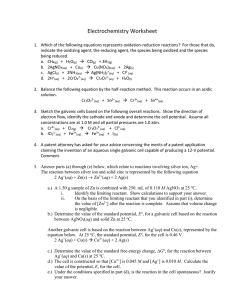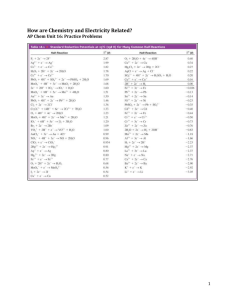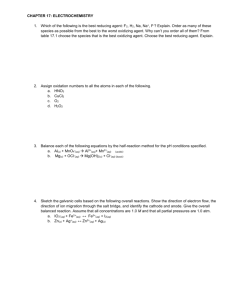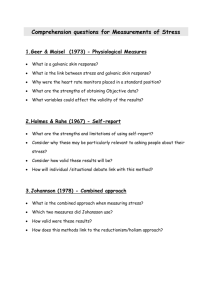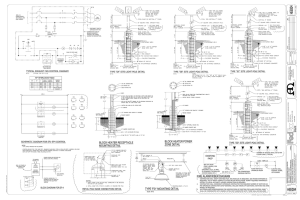File - wilson science WEBSITE
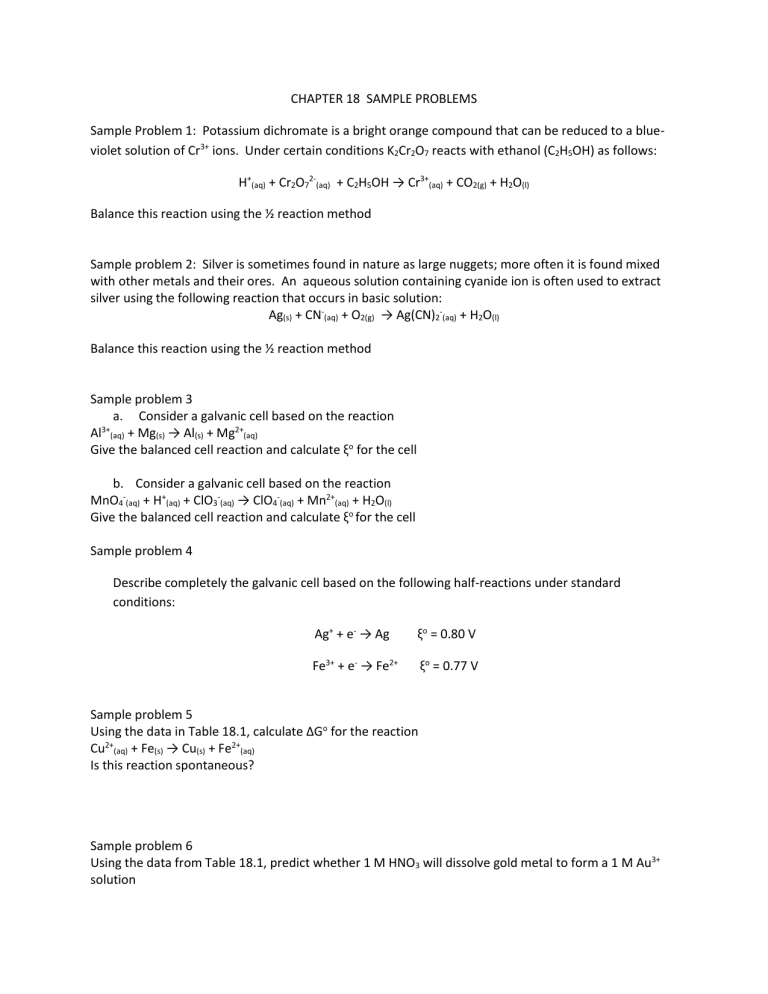
CHAPTER 18 SAMPLE PROBLEMS
Sample Problem 1: Potassium dichromate is a bright orange compound that can be reduced to a blueviolet solution of Cr 3+ ions. Under certain conditions K
2
Cr
2
O
7
reacts with ethanol (C
2
H
5
OH) as follows:
H +
(aq)
+ Cr
2
O
7
2-
(aq)
+ C
2
H
5
OH → Cr 3+
(aq)
+ CO
2(g)
+ H
2
O
(l)
Balance this reaction using the ½ reaction method
Sample problem 2: Silver is sometimes found in nature as large nuggets; more often it is found mixed with other metals and their ores. An aqueous solution containing cyanide ion is often used to extract silver using the following reaction that occurs in basic solution:
Ag
(s)
+ CN -
(aq)
+ O
2(g)
→ Ag(CN)
2
-
(aq)
+ H
2
O
(l)
Balance this reaction using the ½ reaction method
Sample problem 3
Al 3+ a.
Consider a galvanic cell based on the reaction
(aq)
+ Mg
(s)
→ Al
(s)
+ Mg 2+
(aq)
Give the balanced cell reaction and calculate ξ o for the cell b.
Consider a galvanic cell based on the reaction
MnO
4
-
(aq)
+ H +
(aq)
+ ClO
3
-
(aq)
→ ClO
4
-
(aq)
+ Mn 2+
(aq)
+ H
2
O
(l)
Give the balanced cell reaction and calculate ξ o for the cell
Sample problem 4
Describe completely the galvanic cell based on the following half-reactions under standard conditions:
Ag + + e → Ag ξ o = 0.80 V
Fe 3+ + e → Fe 2+ ξ o = 0.77 V
Sample problem 5
Using the data in Table 18.1, calculate ΔG o for the reaction
Cu 2+
(aq)
+ Fe
(s)
→ Cu
(s)
+ Fe 2+
(aq)
Is this reaction spontaneous?
Sample problem 6
Using the data from Table 18.1, predict whether 1 M HNO
3
will dissolve gold metal to form a 1 M Au 3+ solution
Sample problem 7
For the cell reaction
2Al
(s)
+ 3Mn 2+
(aq)
→ 2Al 3+
(aq)
+ 3Mn
(s)
ξ o cell
= 0.48 V predict whether ξ cell is larger or smaller than ξ o cell
for the following cases
[Al 3+ ] = 2.0 M, [Mn 2+ ] = 1.0 M
[Al 3+ ] = 1.0 M, [Mn 2+ ] = 3.0 M
Sample problem 8
Determine the direction of electron flow and designate the anode and cathode for the cell represented in Fig 18.10 (page 854)
Sample problem 9
Describe the cell based on the following half reactions
VO
2
2+ + 2H + + e → VO 2+ + H
2
O ξ o = 1.00 V
Zn 2+ + 2e → Zn ξ o = -0.76 V
Where
T = 25 o C
[VO
2
2+ ] = 2.0 M
[H + ] = 0.50 M
[VO 2+ ] =1.0 x 10 -2 M
[Zn 2+ ] = 0.10 M
Sample problem 10
For the oxidation-reduction reaction
S
4
O
6
2-
(aq)
+ Cr 2+
(aq)
→ Cr 3+
(aq)
+ S
2
O
3
2-
(aq)
The appropriate half reactions are
S
4
O
6
2 + 2e → 2S
2
O
3
2 ξ o = 0.17 V
Cr 3+ + e → Cr 2+ ξ o = -0.50 V
Balance the redox, and calculate ξ o , and K (at 25 o C)
Sample problem 11
How long must a current of 5.00 A be applied to a solution of Ag + to produce 10.5 g of silver metal?
Sample problem 12
How many g of copper can be plated when a current of 10.0 A is passed through a solution of Cu 2+ for 30 minutes?
Sample problem 13
An acidic solution contains the ions Ce 4+ , VO
2
2+ , and Fe 3+ . Using the ξ o values listed in Table 17.1, give the order of oxidizing ability of these species and predict which will be reduced at the cathode of an electrolytic cell at the lowest voltage.
